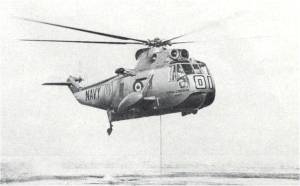The
1960s
The State of the RCN in 1963
Part 6: Aircraft in the RCN
Presentation given to the House of Commons on July 9th, 1963 by Vide-Admiral H.S. Rayner, Chief of Naval Staff.
|
|
|
|
|
TO COMPLETE the picture of RCN A/S vehicles I we should now look at carrier aircraft, and Figure 10 shows a CS2F or Tracker.
We
have 72 of these modern fixed-wing A/S aircraft, up to 18 of which
are carried in the Boiiaventure. The remainder are shore-based,
where some are employed for advanced operational training, and others
are available as back up for the carrier. The Trackers carry submarine
detection equipment and anti-submarine torpedoes.
Figure 11 shows the HSS-2 helicopter using its dunking sonar. Dunking or dipping sonar is the name given to the helicopter’s submarine detection device. It is similar in principle to the variable depth sonar which I described earlier.
The
HSS-2 is the latest A S helicopter, and was designed in the United
States specifically for A/S operations. It is an all-weather helicopter
and in addition to its dunking sonar for the detection of submarines
it carries anti-submarine torpedoes for the attack.
Six of these helicopters will be carried in the Bonaventure and one will be carried on each of the converted St. Laurent class destroyer escorts. Three CHSS-2s have recently been supplied to the RCN.
|
Figure
10: A Tracker aircraft (CS2F) as borne in HMCS BONAVENTURE.
(DNS-23997)
(Click image for a larger version) |
|
Figure
11:The HSS-2, latest A/S helicopter, which is being acquired
by the RCN. (CN-6572-R)
(Click image for a larger version) |
>>> Go to Next Page

